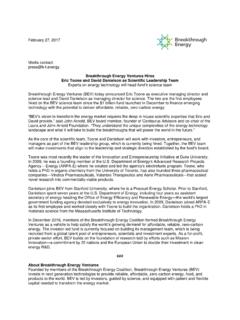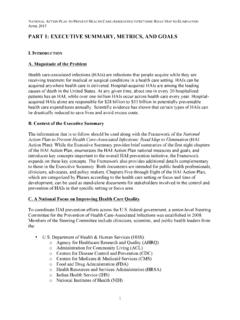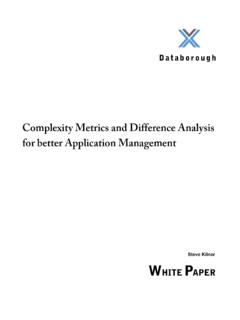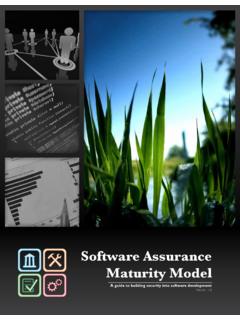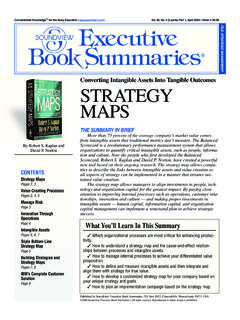Transcription of Advancing the Landscape of Clean Energy Innovation
1 Advancing the Landscape of Clean Energy Innovation Executive2018. February, summary February 2019. Prepared for Breakthrough Energy Coalition by by IHS Markit and Energy Futures Initiative Advancing the Landscape of Clean Energy Innovation , February 2019 1. Foreword We are pleased to submit our report, Advancing the Landscape of Clean Energy Innovation . In this report we describe today's ecosystem of Clean Energy Innovation from the perspectives of technological potential, investment patterns, institutional roles, and public policy. The report identifies critical strengths and weaknesses of this ecosystem and offers recommendations for making that ecosystem more effective.
2 It examines the different technology readiness stages through which Innovation passes and the importance of feedback among those stages. It also discusses the significant opportunities to accelerate the pace of Clean Energy Innovation that are presented by rapid advances occurring today across a myriad of technologies originating outside the Energy sector. We would like to emphasize three observations from our report. First, the has shown over many decades an unparalleled capacity to nurture Energy Innovation . This capacity reflects a rich and durable collaboration among government, universities, research institutions, industry, and entrepreneurs.
3 This collaboration is grounded in the belief that Energy Innovation contributes importantly to economic growth, Energy security, and environmental stewardship. Second, even with our capacity to innovate, and even with the emergence of innumerable technological opportunities, there are significant challenges in moving forward with Clean Energy technology. These challenges arise from the sheer size and complexity of existing systems, the degree to which these systems are embedded in our economy, and the high public expectations of safety and reliability they must meet.
4 Energy systems traditionally have evolved incrementally. Third, these challenges can be met only by building on the collaborative strengths that our ecosystem has already demonstrated. Clean Energy Innovation depends on a national commitment to technological research; private-sector efforts to develop, apply, and commercialize products incorporating that research; and public policy. Advancing the Landscape of Clean Energy Innovation , February 2019 2. In this report we convey the need for a comprehensive approach involving both public and private sectors in order to expand the current Landscape of Clean Energy Innovation and accelerate its processes.
5 We hope that our report contributes to an understanding of the challenges presented and the approaches needed to address those challenges effectively. There is no final word on the subject. We see this report as a contribution to a continuing national dialogue and hope that it will stimulate further discussion, understanding, and action. We are grateful for the opportunity that Breakthrough Energy and its partners have provided to explore this topic and recognize their commitment to Advancing a meaningful and timely national dialogue. We hope that our report informs an appreciation of the complexity, reach, inherent dynamism, and promise of the Clean Energy Innovation Landscape and of the leadership that the United States can continue to provide.
6 Ernest J. Moniz Daniel Yergin Former Secretary of Energy Vice Chairman IHS Markit Project Co-Chairman Project Co-Chairman Advancing the Landscape of Clean Energy Innovation , February 2019 3. Project Team Co-Chairmen Ernest J. Moniz Daniel Yergin Former Secretary of Energy Vice Chairman, IHS Markit Project Directors Melanie Kenderdine Tim Gardner Principal, Energy Futures Initiative Vice President, IHS Markit (EFI) Associates Contributing Authors Energy Futures Initiative IHS Markit (EFI) Associates Atul Arya, Senior Vice President Joe Hezir, Principal Jamey Rosenfield, Senior Vice President Mike Knotek, Distinguished Associate Carolyn Seto, Director Jeanette Pablo, Senior Associate James Coan, Associate Director Alex Kizer, Director Tim Bushman, Senior Analyst The analysis and conclusions of this report are those of IHS Markit and Energy Futures Initiative.
7 IHS Markit and Energy Futures Initiative are solely responsible for its contents. Advancing the Landscape of Clean Energy Innovation , February 2019 4. Advisory Committee Breakthrough Energy , IHS Markit, and Energy Futures Initiative would like to thank these individuals for their invaluable contributions and guidance throughout the course of this project. Matt Baker Jan Mazurek Program Officer Environment, Program Director for Clean Power, William and Flora Hewlett Foundation ClimateWorks Foundation Drew Bond Charlotte Pera Senior Fellow & Director of Energy President and Chief executive Officer, Innovation Programs, American ClimateWorks Foundation Council on Capital Formation Center for Policy Research Jonathan Pershing Program Director Environment, Josh Freed William and Flora Hewlett Foundation Senior Vice President for the Clean Energy Program, Third Way Brook Porter Partner and Co-Founder.
8 G2VP. Kelly Sims Gallagher Professor of Energy and Jeffrey Rissman Environmental Policy at The Fletcher Industry Program Director & Head of School, Tufts University Modeling, Energy Innovation LLC. Director of the Center for International Environment & Ellen Williams Resource Policy, Tufts University Distinguished University Professor, University of Maryland Jason Grumet Former Director, Department of Founder and President, Energy , Advanced Research Projects Bipartisan Policy Center Agency Energy Hal Harvey Jetta Wong Chief executive Officer, President, JLW Advising Energy Innovation LLC.
9 Former Director, Department of Energy , Office of Technology Transitions Advancing the Landscape of Clean Energy Innovation , February 2019 5. executive summary The United States has been at the forefront of Energy Innovation for many decades. One of the most important reasons is the unique and extensive collaboration along the entire chain of Innovation , from basic research to deployment, that engages the federal government, national labs and research institutes, universities, private sector, and state and local governments. This system has given the a global advantage for many decades.
10 The increasing focus on Clean Energy technology solutions and the potential for disruptive changes in Energy systems points to the need for an objective review of the current Clean Energy Innovation ecosystem. How does the Clean Energy Innovation system work? What are its strengths and weaknesses? Is it up to the challenges? And how can it be improved and accelerated? These are the questions that this study seeks to answer. Significant opportunities for Clean Energy Innovation are presented by the changing Energy supply profile; by advances in platform technologies such as digitalization and big data analytics; by expansion of electrification in the transportation and industrial sectors of the economy and the resulting electricity dependence of these sectors; by increases in urbanization and the emergence of smart cities.
